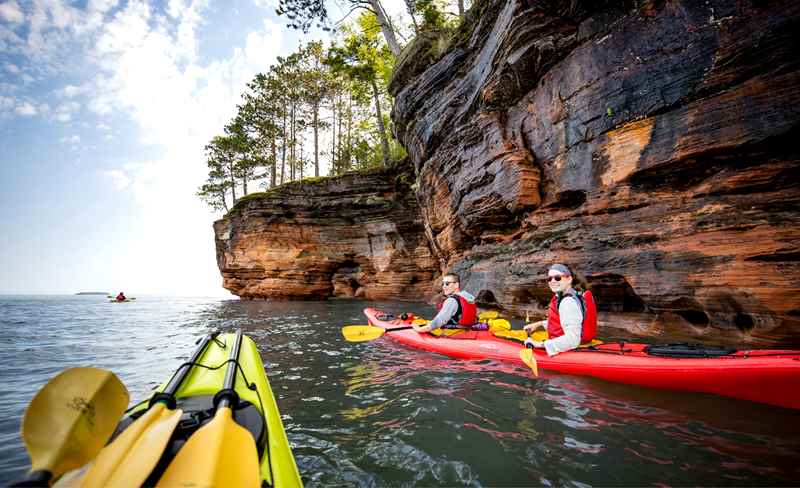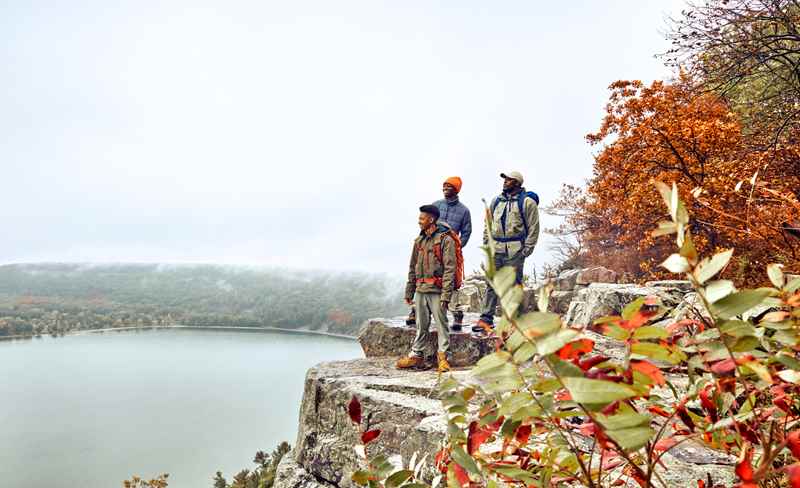
Wisconsin's Geological Wonders Deliver Awe & Unlimited Outdoor Action
Travelers come from near and far to experience these gems with their loved ones in all seasons. Families enjoy splashing along Wisconsin's awe-inspiring shorelines, kayakers stare in wonderment at majestic sea caves, and hikers explore rocky cliffsides and towering waterfalls on paths for all abilities. Nature lovers will find plenty of opportunities to experience Wisconsin's natural wonders in every corner of the state.
ICE AGE NATIONAL SCENIC TRAIL
Spanning more than 1,200 miles through 30 counties, the Ice Age National Scenic Trail is the beating heart of Wisconsin's natural attractions. One of only 11 designated National Scenic Trails within the US - and contained solely within Wisconsin —the path draws locals and visitors alike to its hundreds of access points that highlight astonishing geological features across every region. Wander past kettle lakes and rocky moraines, through rolling prairies and thriving forests — all on one trail.
While traversing the complete route would take even an ardent trekker 8 to 12 weeks, hikers of all levels hop on and off the trail throughout the state. Reconnect with your teen as cell service becomes intermittent along some of the more isolated segments, or make it a getaway for two with a stay in a cozy B&B before or after a hike in one of many designated Ice Age Trail Communities.
APOSTLE ISLANDS NATIONAL LAKESHORE

At the top of Wisconsin, in picturesque Lake Superior, Apostle Islands National Lakeshore rewards visitors with views and terrain that sometimes seem surreal. While it's easiest to see the sights by excursion boat, the island chain's red sandstone caverns beckon the adventurer with up-close possibilities too.
When conditions are right, gather your fellow explorers and take to the water by kayak. Capture enviable selfies as you pass beneath windswept sea caves, formed and worn by waves and weather. In winter, ice alters those photo backdrops dramatically, forming ice palaces within the caves. Eight historic lighthouses occupy six of the islands, with a ninth on the mainland nearby, adding yet another photogenic option. Regardless of season, be sure to consult the National Park Service before venturing out without a guide.
HORICON MARSH
Pack your binoculars. You're guaranteed to spot some of the winged residents of this massive wildlife refuge. Recognized by the United Nations as a Wetland of International Importance, the Horicon Marsh in Fond du Lac and Dodge counties is a crucial rest stop for migrating fowl - serving as a perennial or year-round home for 30 species of birds. Offering a habitat of 33,000 acres, no freshwater cattail marsh in the nation is bigger.
Drive a car or rent a bike for a sightseeing adventure through the marsh, or enjoy hiking or fishing in designated areas where winged and other wildlife species roam.
CHEQUAMEGON-NICOLET NATIONAL FOREST
Everyone is bound to find an activity to suit them in the 1.5 million acres of glorious woodlands and waterways of the Chequamegon-Nicolet National Forest. A superstar of the Northwoods, the forest is a mecca for essentially any recreational pastime best enjoyed in the great outdoors: hiking, horseback riding, camping, boating, paddling, fishing, hunting and, when the snow comes, cross-country skiing, snowshoeing and snowmobiling.
Take a moment from all that activity to admire the towering canopy of trees above. This lush wildland was nearly wiped out by shortsighted logging in the early 20th century, but it is healthy and thriving today thanks to replanting projects by the Civilian Conservation Corps in the 1930s.
NIAGARA ESCARPMENT
Bring your camera and a sense of adventure as you hike, bike or kayak amid the amazing geological formations of the Niagara Escarpment. This continuous limestone ledge snakes in a wide-reaching arc through Illinois, Wisconsin, Michigan and Ontario, eventually creating the cliff New York's iconic Niagara Falls tumbles over near its easternmost end.
Peninsula State Park in Door County provides an awesome introduction to the "Wisconsin Ledge," the 230-mile portion of the escarpment that stretches through eastern Wisconsin. A visit to the escarpment is a step back in time: Created from edges of a sea bottom older than the glaciers that once flowed through the region, it has its own biosystem with more than 200 rare plant and animal species to see.
BIG MANITOU FALLS
When it comes to waterfalls, bigger really is better, and at Big Manitou Falls, you'll see the best. Wisconsin's tallest waterfall by 65 feet, this cascade churns turbulently over a 165-foot drop into the Black River as it courses through Pattison State Park in Douglas County.
Traveling with young hikers? An easy walk through a pedestrian tunnel leads to a breathtaking overlook. Together, see if you can spot where the falls meet the pool below amid the mist in the canyon. Stronger hikers might opt for a steeper trail leading to a stunning downstream view.
CAVE OF THE MOUNDS
Residing at a cool 50 degrees year-round, this underground National Natural Landmark has been described as a "jewel box." The cave was discovered by accident in 1939 while crews were blasting limestone from a farm quarry near Blue Mounds in Dane County. Join one of the daily tours, and watch your children's eyes sparkle like the surrounding scenery as you take in the breathtaking variety and color of the delicate mineral crystal formations called speleothems. Back above ground, crack open geodes or mine for fossils and gems.
LAKE WINNEBAGO
Measuring nearly 132,000 acres, Lake Winnebago holds the title of Wisconsin's largest lake, but it is known for much more than size. No other lake network on the planet legally harvests more lake sturgeon for the sport of it, thanks to longtime smart fish management. Lake sturgeon, a prehistoric fish, has lasted longer than the dinosaurs, battling back from near-extinction in the early 1900s.
Gather some cold-weather gear and your fishing buddies and try your hand at sturgeon spearing during Lake Winnebago's February spearing season — one of only two places in North America where you can try the sport. If ice fishing is a bit too cold for your blood, return later in the year. The lake is also a popular spot for casting in warm weather.
EAGLE RIVER CHAIN OF LAKES
Water lovers, welcome to pure paradise. No chain of freshwater lakes in the world is bigger than this 28-lake chain in the Eagle River and Three Lakes area. Flowing through Vilas and Oneida counties, this collection is just part of the 2,447 lakes in the region — the world's largest freshwater concentration.
Fun for friends and families abound: Water ski, sail, fish, rent a pontoon and watch wildlife. Fans of maritime culture in your group will want to catch the unusual sight of the 1911 Burnt Rollways Dam at Long Lake as boats are hoisted from one water level to another from late May through late September.
INTERNATIONAL CRANE FOUNDATION
A manmade refuge on 300 acres between Baraboo and Wisconsin Dells, the International Crane Foundation is the only place in the world where all 15 types of cranes live. Almost all are threatened or endangered species.
You and your family can see the graceful birds peck and strut in natural settings as you stroll paved outdoor paths in habitat and exhibit space that was recently enlarged through a $10 million expansion. Listen and linger while watching these special birds as you walk on nature trails that cut through prairie, oak savannah and wetland habitats.
DEVIL'S LAKE STATE PARK

It's no wonder Devil's Lake State Park is the most visited state park in Wisconsin, with its stunning, 500-foot-tall quartzite bluffs and a 360-acre lake perfect for swimming, sunbathing and paddling.
But the activities at the state's largest park don't end there. Nearly 30 miles of trails beckon hikers: Set out with a companion or join a guided walk to zero in on plants and wildlife or the park's fascinating history and geology. Effigy mounds and unique rock formations (such as Cleopatra's Needle and Devil's Doorway) pepper these 9,200-plus acres in Sauk County, carved by glacial movement and christened as a state park in 1911.
The diverse landscape of Wisconsin took its shape thousands of years ago as massive glaciers carved their way through the region. This monumental drift left behind an extraordinary environment filled with vibrant wildlife and natural marvels, including 15,000 lakes, lush forests and dramatic bluffs.
Discover new accommodations throughout the Apostle Islands that make this Wisconsin wonder more accessible to travelers, including wheelchair-accessible campsites, boardwalks and a Lake Superior overlook.










